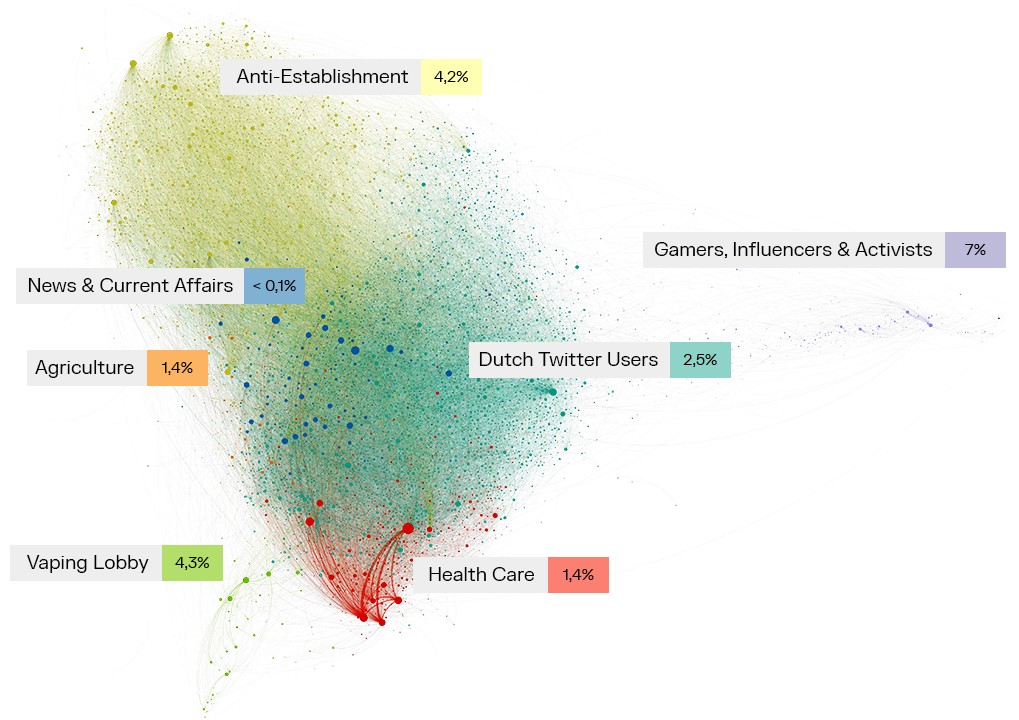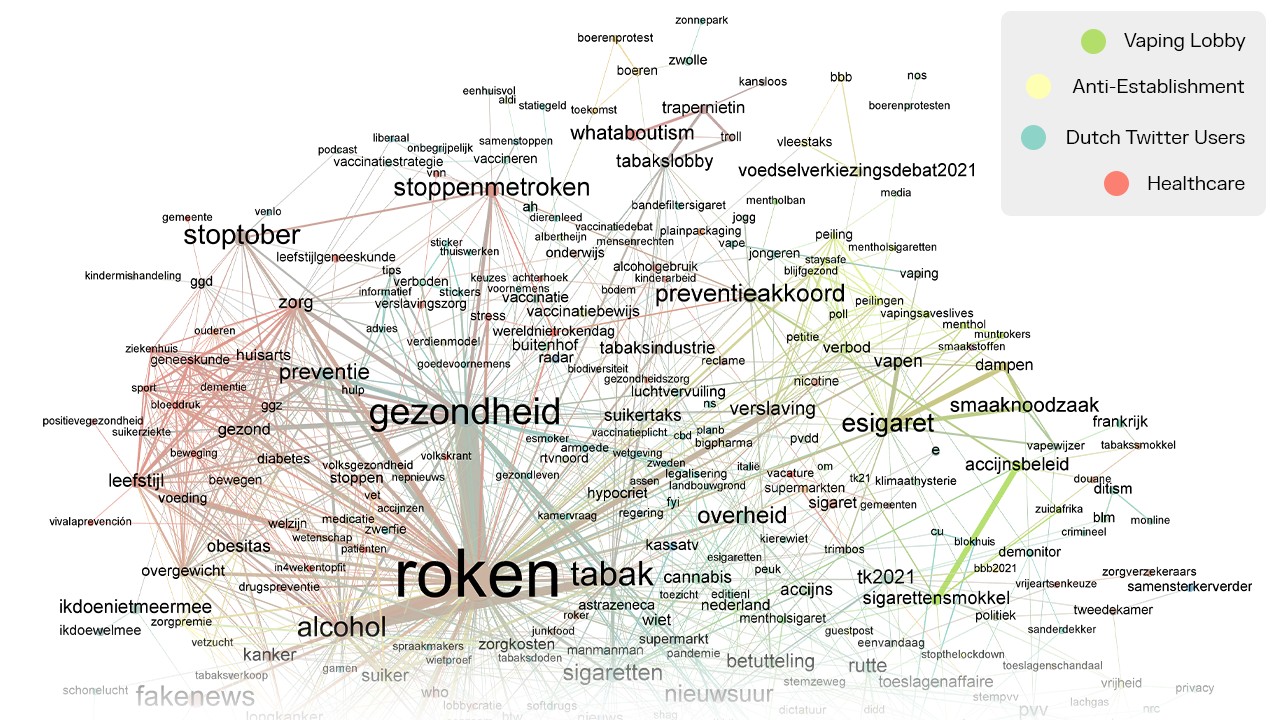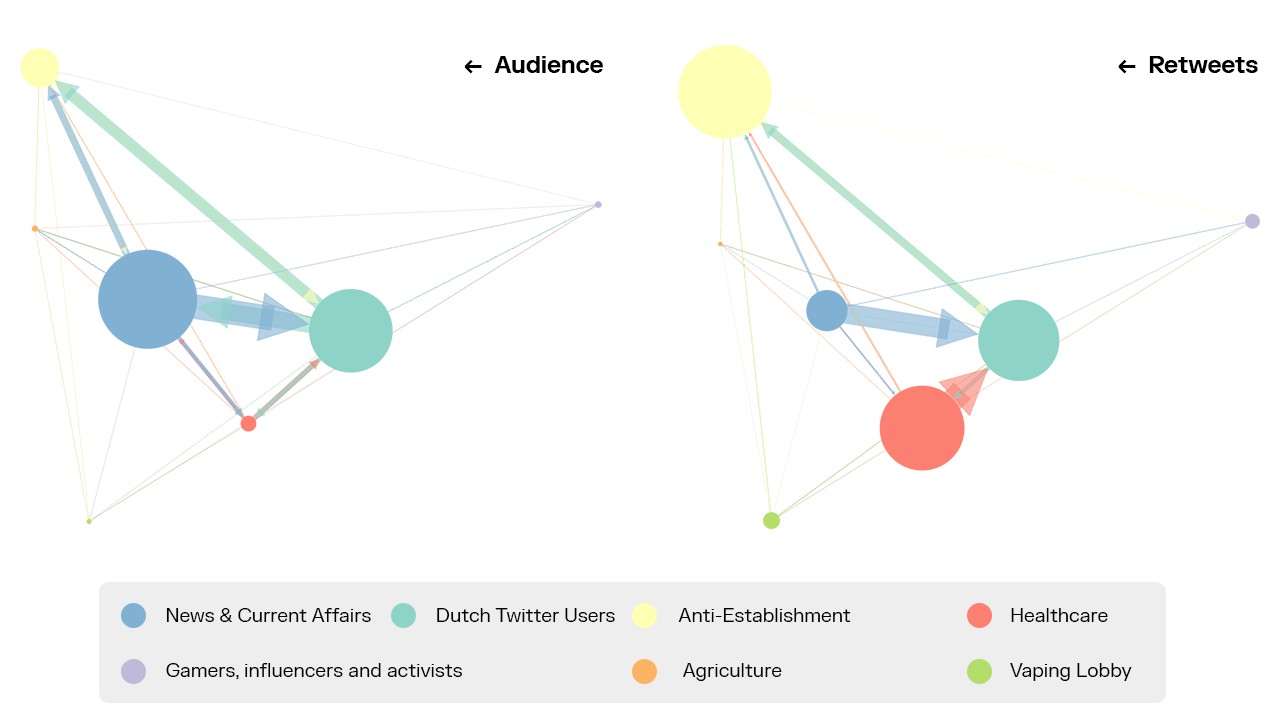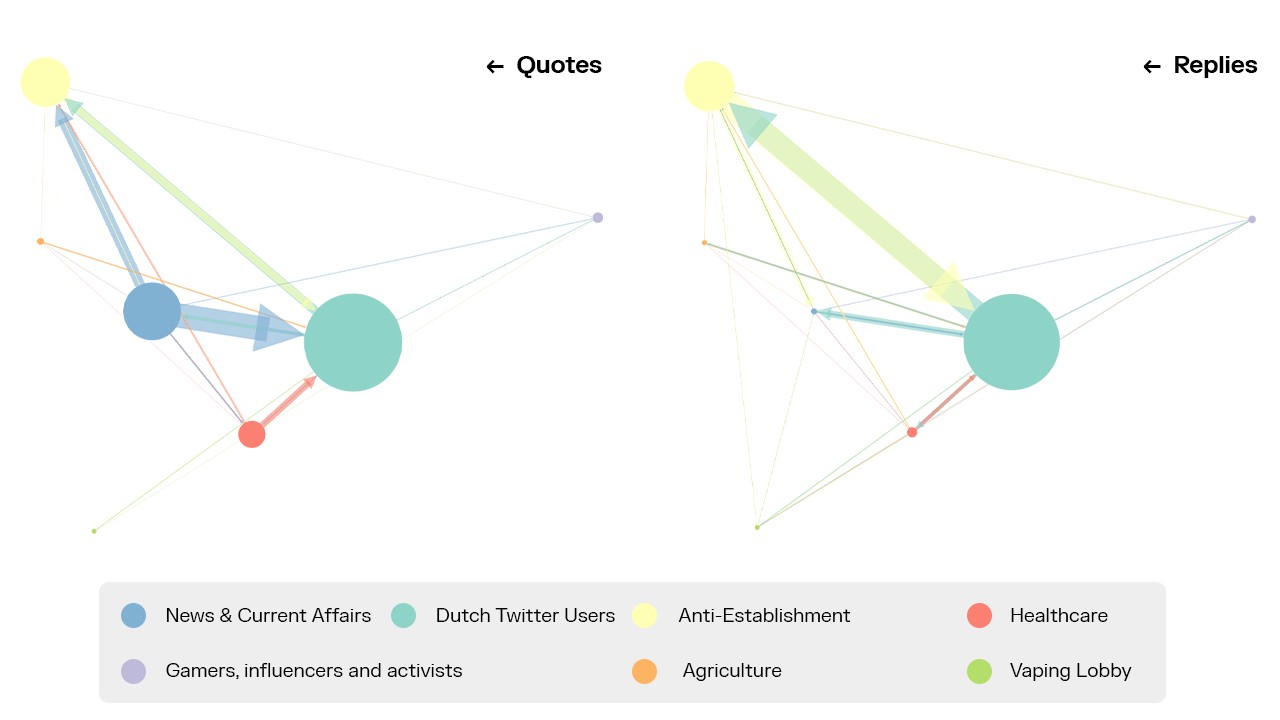How Dutch Twitter users talk about smoking bans
— Academic consortium with Erasmus MC, Center for Media & Health and the University of Groningen,
Children have the right to grow up in a smoke-free environment. Around the world, governments have introduced legislation to make that possible; the Netherlands included. To successfully implement smoke-free laws, policy-makers should know whether they are effective, have a legal basis, and are supported by society.
An academic consortium that included Erasmus MC, the law faculty of the University of Groningen, the Center for Media & Health, and New Momentum studied these aspects. New Momentum specifically examined how Dutch social media users talked about tobacco and smoke-free on Twitter, YouTube, and the open web.

Friction
In the last decade, public spaces such as restaurants, schools, and hospitals have implemented smoking bans. Governments across the world are now preparing and implementing policies to protect children in (semi-)private places such as cars and balconies. These are far-reaching measures, and the extent to which they are supported is still unclear. With this in mind, the success of implementing laws depends on the understanding of public support by the lawmaker.

Social media platforms are part of the societal context in which public support arises. New Momentum, therefore, explored conversations about tobacco and smoke-free policies on Twitter, YouTube, and the open web. Between January 1, 2020, and March 31, 2021, we found 45,666 public Twitter posts written by 21,973 unique users. They were part of an immense network of 13,114,853 Twitter users. By looking at how these users followed each other, we distinguished various communities that each seemed to have their agenda in the discourse on tobacco and smoking.

Momentum
In the network, we found a community of doctors, nurses, and other medical personnel (Health Care) who shared information about the effects of smoking and advocated stricter policies. They were retweeted often by a large community of average Dutch Twitter Users who faithfully follow the mainstream news accounts situated in the News & Current Affairs community.
In contrast, the Anti-Establishment community had doubts about the sincerity of the mainstream media and other institutions such as government and science. Members of the Anti-Establishment said they observed a trend of legislation becoming increasingly restrictive: “You cannot fly; you cannot eat meat… Can I still decide for myself in the future?” While the Anti-Establishment community and the Dutch Twitter Users community are at each other’s throats, the News & Current Affairs community keeps aloof by sticking to providing their followers with information.

“Flying is bad; eating meat is bad – is it still possible to live the way that I want in the future?”
— In the Anti-Establishment community, many Twitter users say they feel patronized.
At the bottom left of the network, we found several Twitter users that are systematically committed to combating stricter legislation on vaping e-cigarettes (Vaping Lobby). They framed vaping as a healthy alternative to smoking. They argued, that if vaping is restricted, more people will continue to smoke and therefore die from it. To back up their arguments, they referred to serious-looking news websites that appear to be funded by US-based conservative organizations and think tanks (1, 2) that campaign for freedom and against laws restricting arms possession, drinking, and tobacco. Their content looks serious and slick, including tear-jerking videos where relatives claim that their deceased parents would still have been alive if they could have vaped undisturbedly.
 These schematic overviews show the mutual relationships between the communities. Each circle represents a community, and their sizes represent the number of followers ('Audience'; left) or retweets ('Retweets'; right). The arrows show to what extent communities have followers from other communities ('Audience'; left) or get retweeted by users in other communities ('Retweets'; right). For example, the News & Current Affairs community has more followers from other communities than it follows these communities back ('Audience'; links); and messages from the Health community are retweeted the most, especially by the Dutch Twitter User community but remarkably little by the Anti-Establishment ('Retweets'; right).
These schematic overviews show the mutual relationships between the communities. Each circle represents a community, and their sizes represent the number of followers ('Audience'; left) or retweets ('Retweets'; right). The arrows show to what extent communities have followers from other communities ('Audience'; left) or get retweeted by users in other communities ('Retweets'; right). For example, the News & Current Affairs community has more followers from other communities than it follows these communities back ('Audience'; links); and messages from the Health community are retweeted the most, especially by the Dutch Twitter User community but remarkably little by the Anti-Establishment ('Retweets'; right).
 These schematic overviews show the mutual relationships between the communities. Each circle represents a community, and their sizes represent the number of quotes ('Quotes'; left) or replies ('Replies'; right). The arrows show to what extent messages get quoted by other communities ('Quotes'; left) or reply to members of other communities ('Replies'; right). For example, the News & Current Affairs community gets quoted relatively often ('Quotes'; left); and the Dutch Twitter Users and the Anti-Establishment respond a lot to each other ('Replies'; right).
These schematic overviews show the mutual relationships between the communities. Each circle represents a community, and their sizes represent the number of quotes ('Quotes'; left) or replies ('Replies'; right). The arrows show to what extent messages get quoted by other communities ('Quotes'; left) or reply to members of other communities ('Replies'; right). For example, the News & Current Affairs community gets quoted relatively often ('Quotes'; left); and the Dutch Twitter Users and the Anti-Establishment respond a lot to each other ('Replies'; right).
The efforts of the Vaping Lobby did not resonate much on Dutch Twitter, partially due to several anti-tobacco activists from the Health Care community committed to unmasking the tobacco industry. They called out lobbyists by name and countered disinformation. Sometimes things got rough: some accounts claimed, for example, that smokers, drinkers, and overweight people are responsible for the ever-increasing costs of health care and are solely responsible for their illness and death. Grist to the mill of members of the Anti-Establishment community, that see their freedom curtailed increasingly. However, it is no reason (yet) to spread the misleading narratives of the Vaping Lobby massively.

Form
Smoke-free policies make it increasingly difficult for tobacco to be a viable business model, and it seems that the tobacco industry has accepted that. Today, the tobacco industry focuses its efforts on mainstreaming the e-cigarette, of which we see proof in this study. In those efforts, the tobacco industry is not very successful (yet) in the Netherlands. Most lobbying work is in English and does not effectively tap into Dutch discourses, despite some accounts among the Anti-Establishment that have actively embraced and promoted ‘vaping as the reasonable alternative to smoking.’
E-cigarettes are not only sold to former chain smokers but also to young people – often enhanced with trendy flavors and fueling addiction with high amounts of nicotine.
— A ban on flavored e-liquids puts a bomb under the tobacco industry’s business model of making young people addicted to guarantee future clientele.
An argument that we came across often is that, although research suggests that vaping is harmful, it appears to be less harmful than smoking tobacco. Many heavy smokers admit that vaping actually has been a reasonable alternative to their former habit. However, much more research is needed to establish how harmful vaping is. Meanwhile, e-cigarettes are not only sold to former chain smokers but also to young people, often enhanced with trendy flavors to make them more accessible and nicotine to make them more addictive. The ban on flavored e-liquids that the Dutch government has been preparing desires to prevent just that and puts a bomb under the tobacco industry’s business model of making young people addicted.
The Erasmus MC, University of Groningen, and the Center for Media & Health are currently finishing up their research. Ultimately, the project desires to provide a number of recommendations to the government and health institutions to guarantee a smoke-free environment for children.
